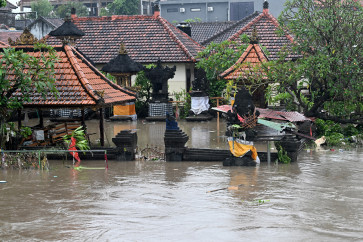Popular Reads
Top Results
Can't find what you're looking for?
View all search resultsPopular Reads
Top Results
Can't find what you're looking for?
View all search resultsGreen insurance a promising new climate opportunity
At a global level, insurance products tend to concentrate on energy efficiency, including clean energy, hybrid vehicles and green building certification, although their nature varies widely.
Change text size
Gift Premium Articles
to Anyone
I
n recent years, green loan disbursement and the issuance of green bonds in Indonesia have continued to rise as awareness of climate change increases. However, green insurance product development in Indonesia is experiencing little growth.
Green insurance is more than just a sustainable insurance solution; it contributes to society by accelerating the sustainable transformation of the global economy. Therefore, insurance companies play an important role in promoting sustainability and climate resilience by underwriting decisions and investment choices, and by engaging clients on environmental, social and governance (ESG) practices.
At a global level, insurance products tend to concentrate on energy efficiency, including clean energy, hybrid vehicles, and green building certification, although their nature varies widely. Green insurance products are already developed in Indonesia, ranging from agricultural insurance, fishery insurance, earthquake insurance, soil moisture index insurance, etc.
Indonesia has considerable potential to expand its insurance market given the increasing trend toward green residential properties and the prospective electric vehicle (EV) market.
The Indonesian government encourages the national automotive industry to develop an EV ecosystem. Through the Ministry of Energy and Mineral Resources (ESDM), the government is targeting 13 million units of electric two-wheelers and 2 million units of electric four-wheelers by 2030. In terms of EV infrastructure, the Ministry of ESDM is encouraging the development of 32,000 Public Electric Vehicle Charging Stations (SPKLU) and 67,000 Public Electric Vehicle Battery Exchange Stations (SPBKLU) by 2030. From the construction side, the International Finance Corporation (2019) predicted green building financing in Indonesia could reach US$ 200 billion before 2030.
Various policies and regulations have been issued to encourage the development of sustainable financial products and/or services in Indonesia, such as green insurance, including OJK Regulation (POJK) No. 51/POJK.03/2017 concerning the Implementation of Sustainable Finance for Financial Service Institutions, Issuers and Public Companies.
However, industry players find it difficult to develop green insurance products due to the lack of consumer knowledge about green insurance and a lack of industry experts with expertise on the underlying risk and long-term effects of climate change. Another issue that has been raised is the low premium that affects the insurance companies’ profitability. These obstacles make insurance companies reluctant to get involved in green insurance.
There are a limited number of green insurance success stories in Indonesia, and insurance companies are therefore cautious in developing these products. Given the circumstances, Indonesia should take lessons from and follow the best practices of other countries that have developed green insurance products. Switzerland, Canada and China, for example, are more advanced in developing green insurance products.
The Swiss insurance industry has been working on developing green products and policies in a variety of ways, from discounting premium rates for EVs to customizing insurance solutions for solar or geothermal power plants. In Canada, the Canada Mortgage and Housing Corporation (CMHC) has the mandate to increase access to housing, which can be done through the “CMHC Eco Plus” program, in which people can apply for a partial refund of 25 percent of their premium if their home is energy-efficient and they insure it with CMHC.
In Asia, China's insurance industry is gradually enriching green insurance products and services by providing protection and risk management services for things such as green transportation, green buildings, green technology, climate governance, carbon sinks, etc. China has also developed an “environmental pollution liability insurance system” by promoting cooperation between insurance companies and other financial institutions to jointly develop such insurance.
Besides adopting best practices from other countries, there are numerous opportunities to incorporate sustainability into insurance. Insurance companies can expand into other businesses and projects that are currently under development, such as renewable energy. Another potential for new insurance products lies in integrating insurance technology (insurtech) with green insurance. For example, insurance companies could offer travel insurance linked to low-emission aviation applications, or reduced insurance rates for using electric vehicles in tourist areas. Climate product innovation within the insurance sector is important because companies developing successful green insurance products will benefit from brand growth and customer affinity.
With the demand for green talent in the insurance industry outpacing supply, key stakeholders such as the government, educational institutions and the industry as a whole should contribute to investing in green skills. Training, relevant professional qualifications and an online database of information related to green insurance coverage will be imperative in creating a better expertise in the green insurance sector.
Another interesting point is that developing green insurance depends on granular data. Indonesia could set up a database such as The Climate Smart database developed by the California Department of Insurance in the US, which lists the green insurance products currently available to consumers and businesses dealing with climate risk.
Going forward, in addition to conventional green insurance products, Indonesian insurance companies have the potential to create sharia green insurance products such as green takaful (a cooperative Islamic insurance system) buildings, green takaful vehicles and a weather index takaful (to compensate for losses caused by unexpected weather conditions). A takaful contribution or premium reduction can be given for environmentally friendly projects.
***
The writer is a junior analyst at the Financial Services Authority and a graduate of the Vrije Universiteit Amsterdam. The views expressed are her own.










